The Character AI decline feels like a breakup in slow motion.
What started as an exciting, innovative roleplay hub has turned into a source of daily frustration.
Loyal users — some who have been here since 2021 — are finding themselves logging in less, canceling subscriptions, and testing competitors.
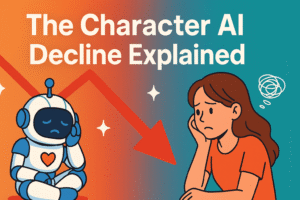
It’s not one bad update or one bad week.
It’s a pattern: every “improvement” chips away at the features that made the platform special.
The magic of immersive, dynamic roleplay is being replaced by short, generic responses, relentless pop-ups, and models that feel like they’re losing IQ by the day.
2023 wasn’t perfect, but it had flow. Conversations felt alive, bots stayed in character, and detailed prompts were rewarded with equally detailed replies. Now, even premium users are reporting quality nosedives. For a growing number of roleplayers, the joy is gone — and so is their patience.
The Symptom List Nobody Asked For
When a platform declines, it’s rarely one glaring flaw. It’s the accumulation of small failures that wear people down. In Character AI’s case, users are pointing to a long list of issues that seem to grow with each update.
The most common complaint is inconsistent response quality. A player might spend five minutes crafting an immersive, two-paragraph prompt — only to get a four-line, rushed reply. Sometimes, the AI nails it once, but then collapses into repetitive, off-context answers for the rest of the day.
Then there’s the app instability. Freezing mid-message, random “chat error” screens, and being forced to close and reopen the app multiple times in a single session. Even those who stick with it say the interruptions break any chance of narrative flow.
Creativity is also on the decline. Roleplayers describe bots recycling the same lines, ignoring carefully set personalities, and defaulting to bland filler.
This has left both casual and dedicated users feeling like they’re doing more of the storytelling work than the AI.
The final frustration? Response length imbalance. Short replies are now the default, regardless of user preference. Those who write long, descriptive prompts expect the same effort in return — but instead, they get replies that feel rushed, like the AI is just trying to get the message over with. For a platform built on engagement, it’s a slow death by under-delivery.
The Monetization Problem
One of the biggest drivers of the Character AI decline isn’t just technical — it’s financial.
Long-time users say the platform has shifted its priorities from delivering a great roleplay experience to squeezing out revenue, often at the cost of the core product.
The most frustrating example is the rise of paywalls around broken features. Premium models are being sold as superior, yet many subscribers report that these “upgraded” bots are just as repetitive and error-prone as the free ones. Some even underperform, giving shorter or more generic responses despite the promise of higher quality.
There’s also the creeping sense of “pay more for less.” Users who’ve stuck with the platform through past hiccups now find themselves paying for C.AI+ while core stability collapses. Lag, chat freezes, and inconsistent memory plague both free and paid tiers — yet monetization pushes forward as if nothing’s wrong.
Then there’s the issue of feature priorities. Instead of fixing bugs or improving response consistency, development cycles are being spent on add-ons like stickers, profile badges, and UI tweaks nobody asked for. It’s not that small updates are bad; it’s that they’re arriving while foundational problems remain untouched.
For many, it feels like Character AI is chasing short-term profit over long-term loyalty. Once users start associating a brand with broken promises and upsells, they don’t just cancel — they look for alternatives. And increasingly, they’re finding them.
Censorship That Breaks Immersion
Even if the bugs and monetization issues vanished overnight, one part of the Character AI decline would still drive users away: the heavy-handed censorship.
For roleplayers, immersion is everything. You set a scene, build a character, and get lost in the world you’ve created. But now, at the worst possible moments, conversations grind to a halt with an abrupt “you know what” pop-up or a moderation block that derails the entire exchange.
This isn’t about removing illegal content — it’s about the overreach that treats every user like they can’t make their own choices. Adult roleplayers, who joined the platform specifically for mature or nuanced storytelling, find themselves being cut off mid-scene for vague reasons.
Sometimes it’s not even clear what triggered the block, which leaves users guessing and rewriting scenes in frustration.
The bigger problem is how these interruptions break flow. Good RP thrives on pacing. Dialogue and action move naturally, tension builds, and characters grow.
When an AI suddenly drops the narrative to deliver a moral reminder, it’s like a film cutting to a commercial in the middle of the climax. You lose the rhythm — and often, the motivation to continue.
Many users aren’t asking for “anything goes” content. They’re asking for control over their own experience. A toggle, a safe mode setting, or even the ability to choose models with more relaxed boundaries could solve most of this. But as it stands, the censorship system isn’t just filtering content — it’s filtering out the fun.
User Backlash and Exodus
The Character AI decline hasn’t just annoyed users — it’s driving them out.
Cancellations are piling up. Some left quietly, others posted public farewells, detailing how the platform went from daily habit to dead tab.
Peak Nyan’s removal was a tipping point. People resubbed for it, only to watch it vanish days later. What replaced it felt bland, repetitive, and rushed.
Alternatives are popping up in every conversation. AI Dungeon. Local LLMs. CrushOn AI. Each one gets tested by disillusioned roleplayers looking for a spark.
The mood has shifted from “I hope they fix it” to “I’m done waiting.” Loyalty has an expiry date, and Character AI is burning through it fast.
Why CrushOn AI Is Picking Up the Slack
When people leave, they’re not quitting roleplay. They’re quitting frustration.
That’s why so many are testing CrushOn AI. It offers what Character AI once did: immersive roleplay, strong memory, and freedom to steer the story.
No heavy-handed blocks killing a scene. Bots stay in character, respond with detail, and keep track of context over time.
Customization runs deeper. You control personality, writing style, and how bold or subtle replies should be.
For users tired of short replies, broken immersion, and upsells, this isn’t just an alternative. It’s a reset.
Can Character AI Recover?
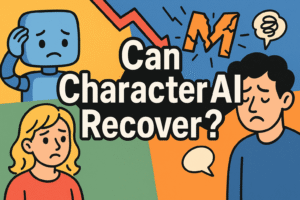
The Character AI decline isn’t irreversible — but fixing it will take more than a patch or two.
They’d need to restore trust, not just features. That means listening to feedback, making quality the priority, and being transparent about updates.
The monetization model would need rethinking. Paywalls around broken features are a quick way to drive loyal users away.
Censorship controls should be optional, giving adults the freedom to choose their own limits. Without that, immersion will keep breaking.
The sad truth is, every week they delay these changes, more users try alternatives — and many won’t come back.
If Character AI wants to avoid becoming a case study in how to squander a lead, they have to start treating their core audience like the asset they are.
Wrap-Up
The Character AI decline isn’t just about bugs or bad updates — it’s about a shift in priorities that’s alienating the very people who built its success. Once you strip away immersion, consistency, and creative freedom, no amount of stickers or UI tweaks will keep roleplayers engaged.
For many, the answer isn’t waiting for a comeback. It’s moving to platforms like CrushOn AI that put storytelling first and let users shape their own experience. Whether Character AI can turn things around is uncertain. What’s clear is that roleplayers will always follow the fun — and right now, it’s happening elsewhere.
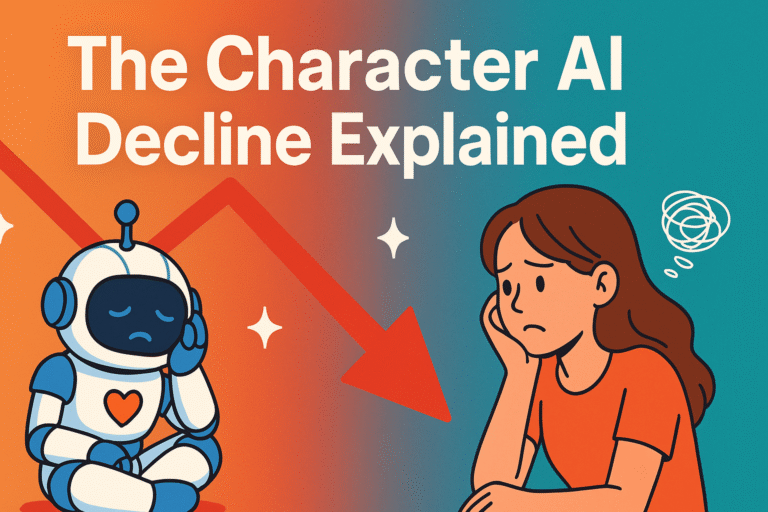
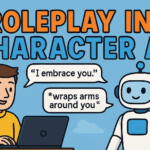
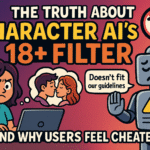
Pingback: 20 Best Character AI Alternatives in 2025 - AI TIPSTERS
Pingback: Favorite Character AI Bots in 2025 - AI TIPSTERS